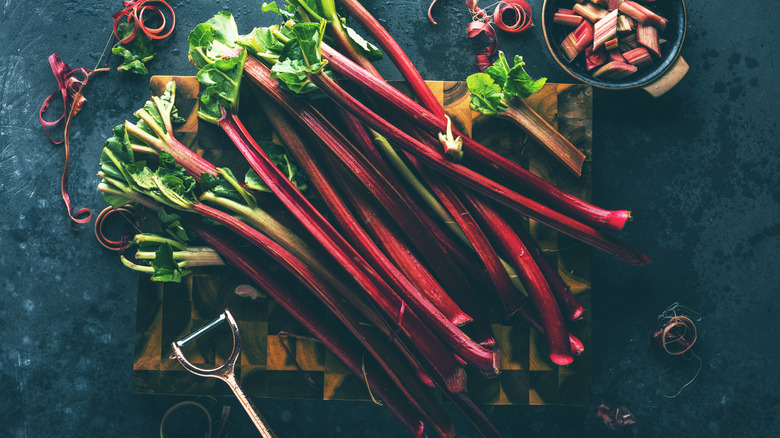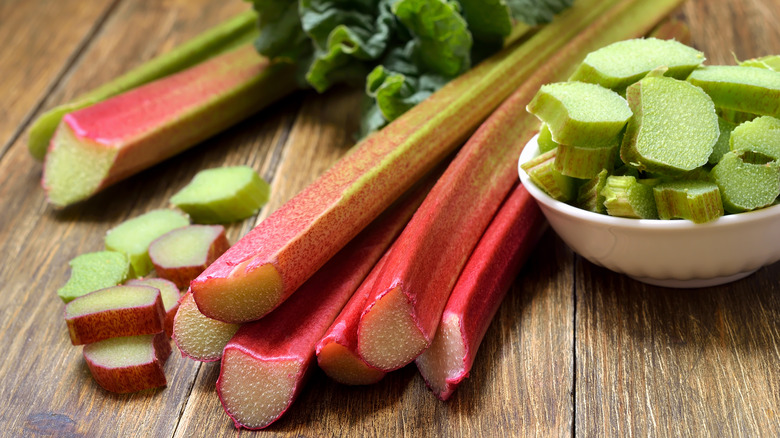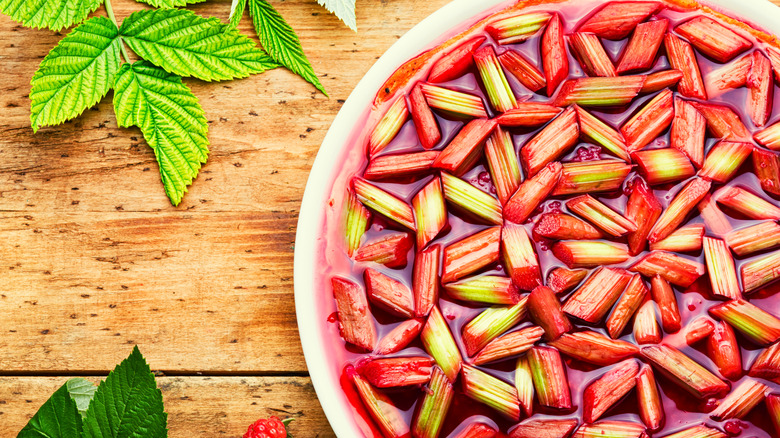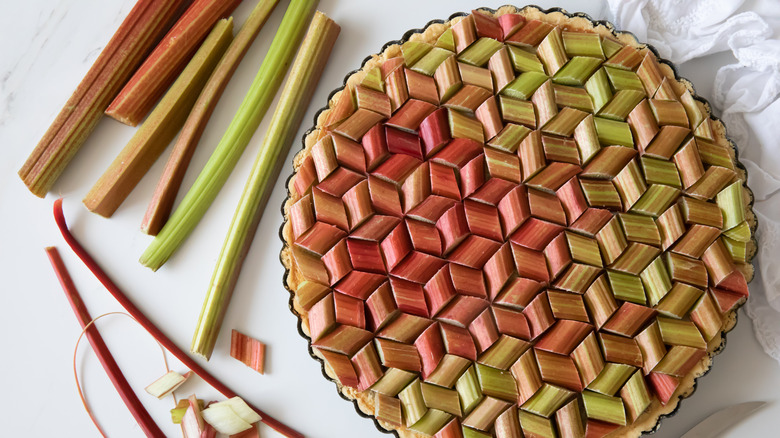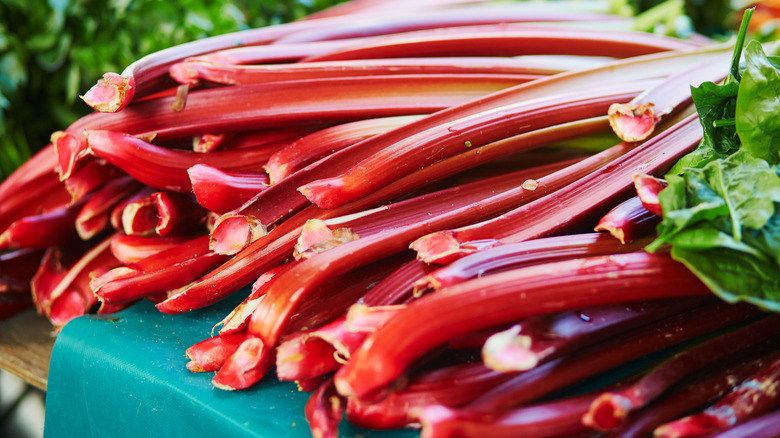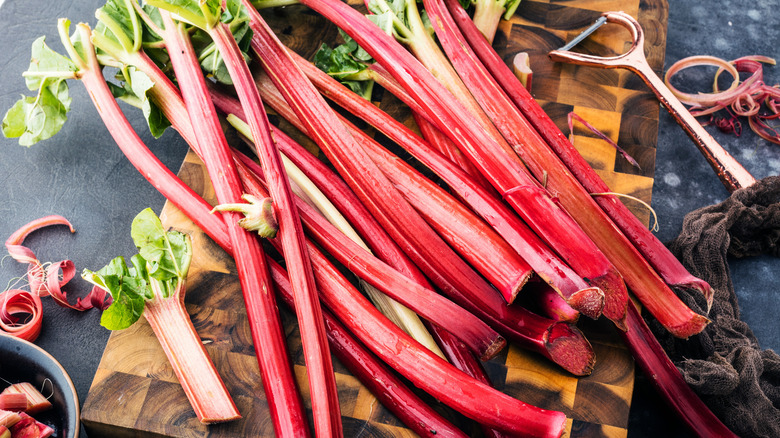What Is Rhubarb And What Does It Taste Like?
With its blushing fibrous stalks topped with curly bright green leaves, rhubarb resembles what celery might look like if you were to tell it a salty joke in mixed company. Known scientifically as Rheum rhabarbarum, this stalky piece of produce sometimes gets referred to as a pie plant and couldn't be more different than celery (via Land O'Lakes).
Rhubarb is comprised of four basic elements. First, the roots of the plant extend horizontally from what's known as a rhizome, or bulb, per University of Wisconsin-Madison. This same root system also resembles those of ginger and irises (via Dummies). Rhubarb roots are not considered edible, but they are sometimes used in Eastern medicine to treat digestive complaints, despite there being little to no scientific evidence of their effectiveness for that purpose, according to WebMD. The reddish-green stalks of the species grow above ground, leaves grow out of the stalks, and at the end of the growing season, seed-containing flowers grow from the plant's stalks. Despite being comprised of four main parts, you don't want to eat most of this vegetable.
What is rhubarb?
While rhubarb leaves might look appetizing, they are actually toxic due to a high concentration of oxalic acid, according to Healthline. This chemical can cause digestive issues, lead to the formation of kidney stones, and even kidney failure. The plant's flower petals don't contain the same acid, but the flower stems do, which is why cooks typically discard the flowers, per Food Forest In Your Garden. The stalk is the only safe and edible part of the vegetable, and luckily, its unique flavor and texture made it a winning ingredient for centuries.
Rhubarb originated in Asia but found its way to Europe in the late 1600s (via Old Farmer's Almanac). It grows best in cooler climates and tends to crown in early spring. This variety of produce can also be grown in greenhouse nurseries and gets referred to as hothouse rhubarb. According to Specialty Produce, field-grown rhubarb has dark red stalks and green leaves. By contrast, the hothouse variety has paler stalks and yellow leaves, has a less pronounced flavor, and tends to be less stringy than the field-grown version. No matter which vegetable you pick up, you know each stalk comes packed with a one-of-a-kind taste.
What rhubarb tastes like
For all intents and purposes, rhubarb's red-tinged stalks are the only edible part of the plant. They can be eaten freshly picked from the garden, stewed, or cooked with sugar to become a pie-filling. When eaten raw, the vegetable has a crunchy texture and fibrous strings similar to celery. Its tart, acidic flavor profile has led some to describe the plant as citrusy while evoking the taste of green apples or grapes (via Chef's Pencil). Rhubarb's sour tang and deeper fruitiness come out, even more, when you prepare it in an oven.
When cooked, the plant's stalk softens and becomes less fibrous while nevertheless retaining its acidic zing. This tart flavor has attracted tons of fans, but many of these eaters prefer that acidic bite when accompanied by a generous helping of sugar or another sweetener. According to Growing History, chefs have served up sweetened and stewed rhubarb as the primary cooking method in the U.S. since the ingredient first started capturing the imagination of New World cooks in the 1700s.
How to cook with rhubarb
While you can eat rhubarb raw, many prefer to first dip the vegetable in something sweet, like maple syrup or honey. You can also enjoy the plant raw, sliced, or diced over ice cream or sweetened yogurt, oatmeal, or with a handful of diced strawberries. You can also toss chopped rhubarb into a blender with lemonade for a lip-puckering tangy beverage (via Taste of Home). Even if you're not a fan of the texture of the uncooked stalks, you can bake the vegetable into tarts, bread, or rhubarb custard bars.
For a classic take on the ingredient, you can turn the stalks into an ideal pie filling on its own, accompanied by strawberries, or in addition to other fruit (via Daily Journal). You might never expect this bright piece of produce to find its way into your typical pie-filling thanks to the ingredient's crunchy, unsweet nature, but this plant has made it into kitchens everywhere thanks to its novel taste and ability to fit into a variety of sweet treats.
Where to buy rhubarb
As a general rule, pick redder and thinner stalks for the most tender and sweet rhubarb around, according to Bon Appétit. When you want to grab a handful of this crimson produce, you can make an expedition to your local grocery store, farmer's market, or even order some rhubarb online.
Ideally, you might want to keep the differences between hothouse and field-grown rhubarb in mind when shopping, especially if your dish relies on a strain's particular color or texture, per Savor the Rhubarb. Depending on where you're doing your produce shopping and the time of year, you may not actually have a choice between varieties and might only find one particular strain. Either way, make sure to discard any and all of the plant's leaves so pets and children won't accidentally eat any and get sick.
Rhubarb's nutrition content
While some enjoy dipping rhubarb in sugar, you end up with a more wholesome nutritional experience when you enjoy this vegetable raw. According to Self Nutrition Data, raw rhubarb only contains a mere 25 calories per one-cup serving. The ingredient additionally contains 5.5 grams of carbohydrates and 1.3 grams of sugar per serving. Beyond that, the plant packs in 45% of your daily intake of vitamin K1 and 16% of your daily vitamin C.
The stalks also contain a sizable amount of fiber and may lower cholesterol (via Healthline). The benefits don't stop there — this vegetable serves as a significant source of antioxidants. Make sure to add this special ingredient to your next shopping list to enjoy a food that anyone can enjoy raw or baked into a pie. After one bite, anyone can see why diners love this one-of-a-kind piece of produce.
